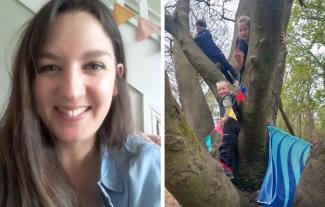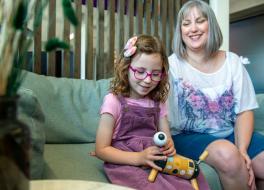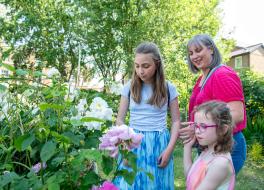Using nature as a group setting for children who stammer

Speech & Language Therapist Rachael Wakefield tells us about 'Stammer in the Woods', her new group in West Yorkshire for children.
I'm Rachael, an independent children's Speech & Language Therapist and certified Outdoors Therapist with a special interest in stammering. In Autumn 2024, I started Stammer in the Woods, an outdoors wellbeing group for 4 to 6 and 7 to 11 year-olds who stammer, after being inspired by attending 'woodland yoga' groups for my own wellbeing.
I had tried yoga before, but always indoors, and found it so hard to switch off and relax. I noticed that this didn't happen when I did woodland yoga, which is practising yoga in an outdoor setting, surrounded by nature. After doing that I felt both calmer and more energised, and the benefits seemed to last all day long.
Nature's benefits
This got me to thinking about how nature settings could help children who stammer. Research has indicated that children who stammer may experience more incidents of bullying in school, may have difficulties with emotional regulation, and can experience negative feelings towards their stammer from a young age. It is, therefore, especially important for children who stammer to receive support to learn about their emotions and regulation strategies, build confidence, resilience and self-advocacy to feel good about talking, and have opportunities to build friendships and support networks.
Through my Outdoors Therapist course, I learnt that taking therapy into a nature setting offers so many opportunities to provide these things for children who stammer. Trying out something new such as lighting a campfire, climbing a tree or using tools is a great way to build confidence and resilience in a supportive and safe environment.
Trying out something new such as lighting a campfire, climbing a tree or using tools is a great way to build confidence and resilience in a supportive and safe environment.
Research also shows that spending just 20-30 minutes a day amongst nature can reduce stress hormones, providing a perfect environment for learning deep breathing and grounding techniques to reduce anxiety and stress.
The outdoors is also a great alternative setting for those children who may find traditional, indoors therapy more of a challenge. For example, in the outdoors we can use a 'shoulder to shoulder' approach, gathering kindling or making something with our hands whilst we chat. This removes the pressure of an expected response and the intensity of eye contact. Children are also free to move their bodies, run, climb, swing etc, rather than being confined to a room or sitting at a table.
It is also my hope that Stammer in the Woods will support a life-long nature connection for the children, helping them grow into adults who know how to use the outdoors as a freely available self-care strategy.
Sessions
A typical session of Stammer in the Woods begins with a low-pressure welcome activity such as gathering kindling for our campfire and using fire steels to get the fire going. Next, we might run through a grounding activity to settle ourselves into our environment, learning simple strategies for use in real-life situations if we are feeling anxious or stressed.
Then it's free play time, a great opportunity to build on friendships and confident communication. Children enjoy tree climbing, using tools, woodland crafts, campfire cooking, and much more. Throughout the session we will share positive stammering messages based on self-advocacy and stammering pride. At the end of the session we might do a book share, swapping story books about stammering to take home with us.
So far, parents have shared positive feedback that their children seem to mind less about stammering, that they have become more open and accepting of their stammers and even talked about stammering in school for show-and-tell.
Children have told me that they have used the grounding techniques in real-life situations to help them to feel less anxious. Younger children have learnt what the word 'stammer' means and have learnt about the stammering pride flag.
It is my hope that Stammer in the Woods will continue to grow, providing more support for children of all ages, and their families, to feel better about using their important voices and to know how to use nature to help them on their stammering journeys.
If you live in the West Yorkshire area and have a child who stammers, we'd love for you to join us in the woods! Find out more at stammerinthewoods.co.uk or follow our adventures on Instagram @stammerinthewoods.
As Rachael mentions, Stammer in the Woods is run by her, an independent speech & language therapist, rather than STAMMA, and costs £20 per session. For a list of other groups out there, see our Communities & Groups page.

































